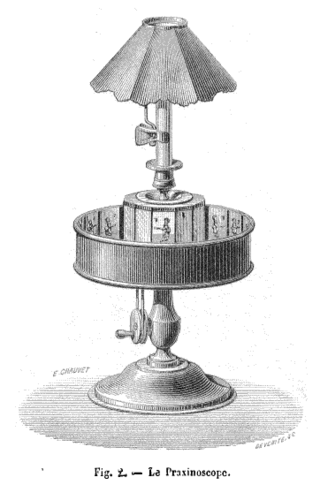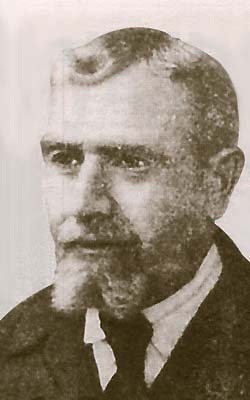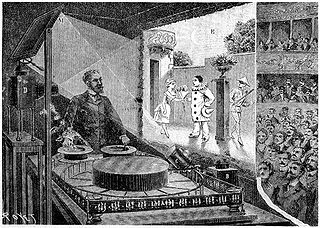Related Research Articles

Charles-Émile Reynaud was a French inventor, responsible for the praxinoscope and was responsible for the first projected animated films. His Pantomimes Lumineuses premiered on 28 October 1892 in Paris. His Théâtre Optique film system, patented in 1888, is also notable as the first known instance of film perforations being used. The performances predated Auguste and Louis Lumière's first paid public screening of the cinematographe on 26 December 1895, often seen as the birth of cinema.

The praxinoscope was an animation device, the successor to the zoetrope. It was invented in France in 1877 by Charles-Émile Reynaud. Like the zoetrope, it used a strip of pictures placed around the inner surface of a spinning cylinder. The praxinoscope improved on the zoetrope by replacing its narrow viewing slits with an inner circle of mirrors, placed so that the reflections of the pictures appeared more or less stationary in position as the wheel turned. Someone looking in the mirrors would therefore see a rapid succession of images producing the illusion of motion, with a brighter and less distorted picture than the zoetrope offered.

Aleksandr Alekseevich Khanzhonkov was a pioneering Russian cinema entrepreneur, film director and screenwriter. He is known for producing Defence of Sevastopol, Russia's first feature film, as well as Ladislas Starevich's ground-breaking stop motion animation. Most of his career was in Russian Empire. During 1923-1926 he worked in the Soviet Union, where his career ended with a financial scandal, however his past achievements earned him a personal pension and an apartment from the state.

The Théâtre Optique is an animated moving picture system invented by Émile Reynaud and patented in 1888. From 28 October 1892 to March 1900 Reynaud gave over 12,800 shows to a total of over 500,000 visitors at the Musée Grévin in Paris. His Pantomimes Lumineuses series of animated films include Pauvre Pierrot and Autour d'une cabine. Reynaud's Théâtre Optique predated Auguste and Louis Lumière's first commercial, public screening of the cinematograph on 28 December 1895, which has long been seen as the birth of film.
The decade of the 1870s in film involved some significant events.
For the history of animation after the development of celluloid film, see history of animation.
Events in 1900 in animation.
Events in 1892 in animation.
Events in 1889 in animation.
Events in 1888 in animation.
Events in 1882 in animation.
Events in 1880 in animation.
Events in 1879 in animation.
Events in 1878 in animation.
Events in 1876 in animation.
Events in 1873 in animation.
Events in 1868 in animation.
Events in 1862 in animation.
References
- ↑ Muybridge, Eadweard (September 24, 2012). Animals in Motion. Courier Corporation. ISBN 978-0-486-12999-0.
- ↑ Bendazzi 1994, p. 4.
- ↑ Myrent 1989, p. 192-193.
- ↑ Cutter, Susan L.; Harrington, J.W. Jr. (31 March 2004). Brunn, Stanley D. (ed.). Geography and technology. Dordrecht: Kluwer Academic Publishers. p. 274. ISBN 978-1402018718.
- ↑ Chandramouli, Magesh (2021). 3D Modeling & Animation: A Primer. CRC Press. p. 181. ISBN 9781498764926.
- ↑ "Le Praxinoscope à projection". emilereynaud.fr (in French). Retrieved 2019-07-25.
- ↑ Laurent Mannoni, The great art of light and shadow : archaeology of the cinema (1995)
- ↑ Reynaud, Émile (1888-12-01). Brevet d'invention N° 194 482.
- ↑ Markstein, Don. Toonopedia.
- ↑ Lenburg, Jeff. Who's Who in Animated Cartoons: An International Guide to Film & Television. Applause, 2006.
- ↑ Smith profile, Lambiek's Comiclopedia. Accessed Jan. 2, 2018.
- ↑ Lenburg, Jeff (1999). The Encyclopedia of Animated Cartoons. Checkmark Books. p. 26. ISBN 0-8160-3831-7 . Retrieved 6 June 2020.
- ↑ Lenburg, Jeff (1999). The Encyclopedia of Animated Cartoons. Checkmark Books. p. 29. ISBN 0-8160-3831-7 . Retrieved 6 June 2020.
- ↑ Ruhlmann, William. "Billy Murray". Allmusic . Retrieved October 14, 2011.
- ↑ "The Walter Lantz Cartune Encyclopedia: 1930". The Walter Lantz Cartune Encyclopedia. Archived from the original on May 14, 2011. Retrieved April 24, 2011.
- ↑ "Billy Murray: A Biography". The Official Website of Billy Murray (1877–1954). Phonostalgia. Retrieved October 14, 2011.
- ↑ Smith, Dave (2012). Disney Trivia from the Vault: Secrets Revealed and Questions Answered: Secrets Revealed and Questions Answered. Disney Electronic Content. ISBN 978-1-4231-7857-6 . Retrieved 10 July 2020.
- ↑ Jeff DePaoli (February 16, 2022). "Dizney Coast to Coast - The Unofficial Disney Fan Podcast (The Voice of Minnie Mouse: An Interview with Kaitlyn Robrock)". Dizney Coast to Coast (Podcast). DePodcast Network. Event occurs at 13:14. Retrieved February 17, 2022.
- ↑ Kaufman, J.B.; Gerstein, David (2018). Walt Disney's Mickey Mouse: The Ultimate History. Cologne: Taschen. pp. 345–348. ISBN 978-3-8365-5284-4.
- ↑ Peter Rollberg (2016). Historical Dictionary of Russian and Soviet Cinema. — Rowman & Littlefield, p. 366 ISBN 978-1-4422-6842-5
- ↑ Richard Abel (2005). Encyclopedia of Early Cinema. — Routledge: London and New York, p. 356 ISBN 0-415-23440-9
- ↑ Tsivian, Yuri (1991). Early Cinema in Russia and Its Cultural Reception. p. 132.
- ↑ Marina Parkhomenko. Life and Death of Aleksandr Khanzhonkov interview with granddaughter Irina Orlova, Evening Donetsk newspaper № 153 (7825), October 17, 2003 (in Russian)
- ↑ Irina Orlova (2007). Dedicate My Life to Cinema. — Donetsk: Promin, 127 pages (Biography)
- ↑ Interview with Aleksandr Khanzhonkov's granddaughter Irina Orlova from the Evening Donetsk newspaper № 73, May 18, 2007 (in Russian)
- ↑ Maxim Medvedev. A slave of cinema in the garden of the parting paths Archived 2022-02-18 at the Wayback Machine article at Chastny Korrespondent, August 8, 2014 (in Russian)
- ↑ "Harry Hemsley". lambiek.net. Retrieved May 19, 2020.